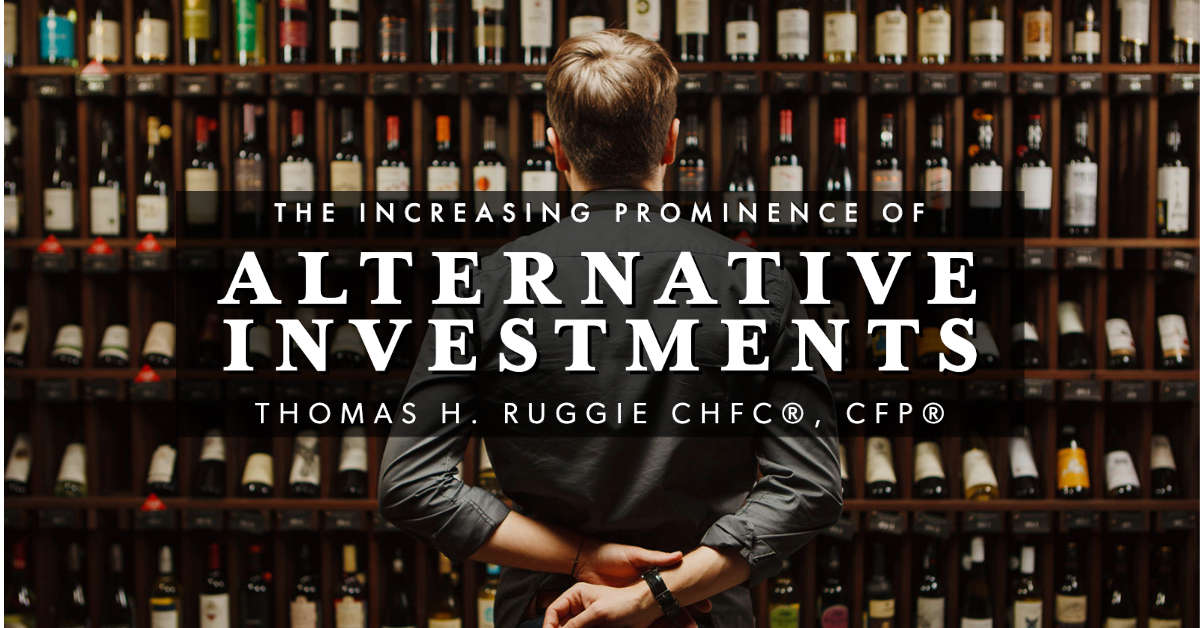
The Increasing Prominence of Alternative Investments
by Thomas H. Ruggie, ChFC®, CFP®
Originally Published on Forbes.com
Alternative investments that provide an “alternative” to the more traditional investment universe of stocks and bonds, are becoming less “alternative” as greater numbers of ultra-high-net-worth individuals and similarly qualified investors seek potentially greater returns in ways that don’t automatically necessitate greater risk. A recent EY report found that 81% of ultra-high-net-worth investors surveyed, hold alternative investments in their portfolios (EY Global Wealth Research Report – 2021).
For the appropriate investor, alternatives offer a range of opportunities that can support specific investment strategies and objectives, including the tailoring of risk management profiles, balancing of risk against return based on risk tolerances, and meeting of specific investment goals, such as the preservation of capital during periods of market volatility. And while all investments come with some degree of risk, alternatives offer the potential for significant upside when compared with more traditional asset classes.
There is another vantage point from which to view alternatives: the perspective of ultra-high-net-worth individuals and families and their personal aspirations to impact the world around them. A recent report by KKR found, “A significant and growing number of HNW families are focused on social change, using their assets to promote education equity, environmental progress, disease cures, and medical research, alongside other public objectives.” (KKR Insights: The Ultra-High-Net-Worth Investor – Coming of Age)
Let me use myself as an example to illustrate the intersection between alternative investments and the personal passions of an investor. Most of my life I’ve collected sports memorabilia. I started my collection not as an investor, but as someone who loved baseball. That it has grown into a valuable alternative investment has been, over time, a factor of both art and science. A previous article I published on Forbes.com, highlights what a collector/investor needs to consider to protect family members when they stand to inherit this kind of alternative investment, especially when they have no passion for it or understanding of its actual worth. (Forbes: Deconstructing A Collection: Preparing Your Family to Handle Your Investment Down the Road)
The KKR report speaks to the impact ultra-high-net-worth individuals and families may want to have through their alternative investment strategies. Investment opportunities that speak to innovation and seek to solve unanswered needs can be compelling—both as investments and as ways to satisfy the personal visions of the investor.
A specific investment can take on multiple dimensions that must be closely evaluated for appropriateness across a range of criteria that includes considerations other than just risk and return. Investors may want to evaluate their relationship with trusted advisors in terms of vision, mission, and values, alongside more traditional performance metrics. Qualitative and quantitative data points can be important. The commitment and passion of the advisor, for example—may be an interesting, if not valuable, point of reference for individuals or families who are investing.
“For the appropriate investor, alternatives can offer a range of opportunities that can support specific investment strategies and objectives, including the tailoring of risk management profiles, and the meeting of specific investment goals, such as the preservation of capital during periods of market volatility.”
As with most things, alternatives are subject to a range of pros and cons and may not be appropriate investments for many reasons. Transparency into the investments and the liquidity of those investments over time are just two areas where investors should focus attention.
Ironically, while many investors engage with an advisor to take on the work and worry related to investment management, ultra-high-net-worth investors often find themselves more involved than they would be with traditional investments. This is neither good nor bad from the perspective of the investor or advisor but can be another consideration in helping the investor determine the appropriateness of the opportunity, and of alternatives in general.
I don’t see much discussion around the pros and cons for advisors. And while some investors may question why they should care about such things, I believe how an advisor navigates the pros and cons related to alternatives can impact the investor. For example, how is the advisor gaining access to the alternative investments? What people, systems and processes do they have in place, internally and externally through third-party partners and providers?
Considerations such as access can impact the availability and viability of opportunities. How is an opportunity evaluated? Research and vetting can factor in significant ways. How is an investment opportunity made? If with a co-investment, what will influence the degree to which there is transparency into reporting and liquidity? Regarding liquidity, the idea of “patient capital” comes to mind. Is there a clear understanding of how long dollars invested in alternatives will be unavailable to take out of those investments? This can vary widely.
Diversification is an important consideration for alternative opportunities, too. Some advisors, for example, create one “bucket” to meet their ultra-high-net-worth investor’s near-term and ongoing liability and liquidity needs, a second “bucket” to position the client in more traditional asset classes and a “long-term bucket” to give the investor access to investment opportunities that tend to have higher returns but possibly higher risk. In this last bucket, the need for diversification across various alternative investments can work to manage risk further. Types of diversification include diversification by sector or industry; the number of opportunities an investor is invested in; the source of the investment (where it originated); and “vintages,” the year the first significant investment was made.
For the appropriate Qualified Investor, at the appropriate time, alternatives can offer a range of opportunities that can support specific investment strategies and objectives. And while these alternative investments can yield significantly higher returns than traditional investments, there is always the presence of risk and potential loss of capital invested. Before investors commit to investing in alternatives, they should have a clear understanding of their overall financial situation, the amount of money available for investing, their need for liquidity, and tolerance for risk.